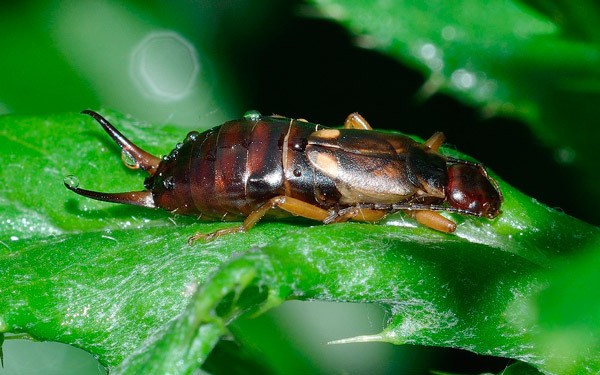Tips for trapping earwigs
Trapping earwigs is easy with a little bit of knowledge and a few readily available materials.
• Know earwigs naturally hide in moist, dark places.
• Create artificial hiding places by:
— Loosely rolling moistened newspapers, cardboard, burlap or similar materials.
— Moistening corrugated cardboard to provide lots of dark tunnels to hide in.
— Capping off one end of a paper towel tube and filling it with drinking straws.
• Try baiting traps with bran flakes or oatmeal.
• Leave traps on soil surface in known problem areas during late afternoon; collect them next morning.
• Tap captured earwigs from the traps into soapy water and dispose of them.
Like a bad dream, you wake up to devoured tender greens and chewed up blossoms in your vegetable garden. Who is the cause of this dreaded event?
With the absence of a silvery-slimy slug trail, the nightmare is more than likely due to Forficula auriculari, an insect commonly known as the earwig.
The common name earwig comes from an old superstition that these insects burrowed into the ears of people during the night; however, there is no truth to that myth. The forceps (pincers) of earwigs are strong in the insect world but cannot puncture human skin. They only look like the subject of a childhood nightmare.
A nocturnal insect requiring moisture and darkness, earwigs hide during the day under soil, debris or in any crack or crevice that provides these conditions. Earwigs surface to feed during the night, eating both plants and animals.
In large numbers earwigs can be severely damaging to food crops as well as ornamentals.
Besides devouring young plant shoots and chewing on flowers, earwigs can further damage fruits and vegetables in your garden by entering and enlarging existing holes.
Crops commonly subjected to foliage injury are bean, beet, cabbage, cauliflower, pea and potato. Sweet corn silks also can be damaged.
With elongated, flattened bodies and forceps at the rear, earwigs have two sets of wings but are poor fliers. The outer wings are short and hard; the inner wings are folded and membranous.
Male adults have a more distinctive curve to their forceps and nymphs resemble the adults although sometimes are paler.
As earwigs overwinter under the surface of the soil, the males generally die off.
Females will lay about 60 eggs once a year in trenches, guarding them through their simple metamorphosis.
Earwigs are most noticeable and their damage most prevalent during July and August.
Populations can be physically controlled by clearing the garden of debris and possible hiding places. Perform weeding chores frequently since they provide shelter, food and mating grounds for earwigs and other garden pests.
A tidy garden is a happy garden, so keep your site clean and debris-free.
Traps can be successful at keeping populations manageable because earwigs have a relatively low reproduction rate. (See the sidebar for trapping ideas.)
If earwigs are too numerous for physical control, a pesticide can be considered. Select a pesticide specified for use against earwigs and follow the directions provided on the product label. If using on or near food crops, be sure to select a pesticide approved for those applications.
Watch out for evil-looking earwigs and take steps to control them as soon as possible. Although harmless to humans, earwigs can take a bite out of your vegetable garden harvest.
Pearl of Wisdom
Earwigs are not all bad. They can be beneficial insects in the garden as they feed on smaller pests such as aphids, beetle larvae, fleas, leaf-roller eggs, maggots, mites and slug eggs. As scavengers, earwigs play a part in garden clean-up, turning garden debris into organic matter.
For more
For more gardening information, attend the Brown Bag Series at the Clallam County Courthouse. These free educational events are held at noon on the second and fourth Thursday of each month. On June 23, Victor Gonzales from Victor’s Lavender in Sequim will talk about growing lavender on the North Olympic Peninsula.
Michele Mangiantini is a WSU-certified Clallam County Master Gardener.



